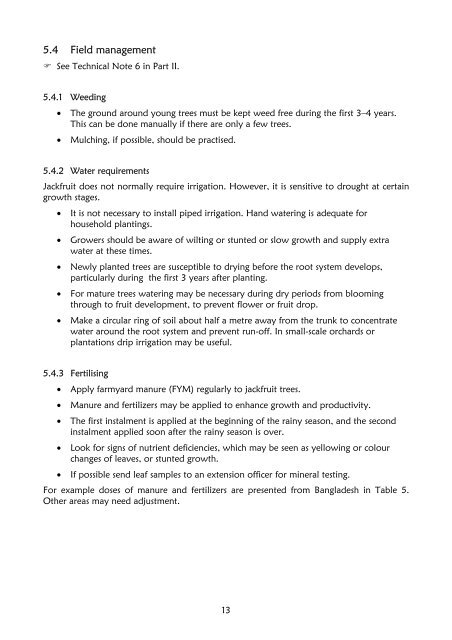Jackfruit extension manual.pdf - Crops for the Future
Jackfruit extension manual.pdf - Crops for the Future
Jackfruit extension manual.pdf - Crops for the Future
Create successful ePaper yourself
Turn your PDF publications into a flip-book with our unique Google optimized e-Paper software.
5.4 Field management<br />
See Technical Note 6 in Part II.<br />
5.4.1 Weeding<br />
• The ground around young trees must be kept weed free during <strong>the</strong> first 3–4 years.<br />
This can be done <strong>manual</strong>ly if <strong>the</strong>re are only a few trees.<br />
• Mulching, if possible, should be practised.<br />
5.4.2 Water requirements<br />
<strong>Jackfruit</strong> does not normally require irrigation. However, it is sensitive to drought at certain<br />
growth stages.<br />
• It is not necessary to install piped irrigation. Hand watering is adequate <strong>for</strong><br />
household plantings.<br />
• Growers should be aware of wilting or stunted or slow growth and supply extra<br />
water at <strong>the</strong>se times.<br />
• Newly planted trees are susceptible to drying be<strong>for</strong>e <strong>the</strong> root system develops,<br />
particularly during <strong>the</strong> first 3 years after planting.<br />
• For mature trees watering may be necessary during dry periods from blooming<br />
through to fruit development, to prevent flower or fruit drop.<br />
• Make a circular ring of soil about half a metre away from <strong>the</strong> trunk to concentrate<br />
water around <strong>the</strong> root system and prevent run-off. In small-scale orchards or<br />
plantations drip irrigation may be useful.<br />
5.4.3 Fertilising<br />
• Apply farmyard manure (FYM) regularly to jackfruit trees.<br />
• Manure and fertilizers may be applied to enhance growth and productivity.<br />
• The first instalment is applied at <strong>the</strong> beginning of <strong>the</strong> rainy season, and <strong>the</strong> second<br />
instalment applied soon after <strong>the</strong> rainy season is over.<br />
• Look <strong>for</strong> signs of nutrient deficiencies, which may be seen as yellowing or colour<br />
changes of leaves, or stunted growth.<br />
• If possible send leaf samples to an <strong>extension</strong> officer <strong>for</strong> mineral testing.<br />
For example doses of manure and fertilizers are presented from Bangladesh in Table 5.<br />
O<strong>the</strong>r areas may need adjustment.<br />
13

















